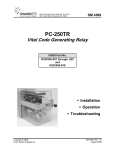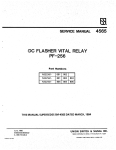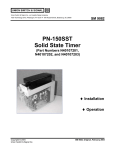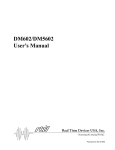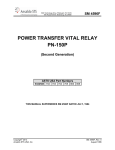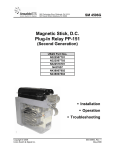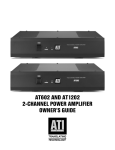Download SM-4568B - Ansaldo STS
Transcript
Union Switch & Signal Inc., an Ansaldo Signal company 1000 Technology Drive, Pittsburgh, PA 15219 ● 645 Russell Street, Batesburg, SC 29006 SM 4568B PN-250CG Code Generator US&S Part No. N40105601 N40105602 N40105603 N40105604 N40105605 N40105606 N40105607 N40105608 N40105609 N40105610 N40105611 N40105612 N40105613 N40105614 N40105616 N40105617 N40105618 N40105619 N40105620 N40105621 N40105622 ♦ Installation ♦ Operation ♦ Maintenance Copyright © 2006 Union Switch & Signal Inc. Rev 1 July 2006 Proprietary Notice This document and its contents are the property of Union Switch & Signal Inc. (hereinafter US&S). This document has been furnished to you on the following conditions: no right or license under any patents or any other proprietary right in respect of this document or its content is given or waived in supplying this document. This document and its contents are not to be used or treated in any manner inconsistent with the rights of US&S, or to its detriment, and are not to be copied, reproduced, disclosed to others, or transferred without the prior written consent of US&S. Important Notice US&S constantly strives to improve our products and keep our customers apprised of changes in technology. Following the recommendations contained in the attached service manual will provide our customers with optimum operational reliability. The data contained herein purports solely to describe the product, and does not create any warranties. Within the scope of the attached manual, it is impossible to take into account every eventuality that may arise with technical equipment in service. Please consult your local US&S Account Executive in the event of any irregularities with our product. We expressly disclaim liability resulting from any improper handling or use of our equipment, even if these instructions contain no specific indication in this respect. We strongly recommend that only approved US&S spare parts be used as replacements. SM 4568B, Rev 1, July 2006 i Revision History Revision History ii Rev. Date Nature of Revision Original January 2000 Original Issue 1 July 2006 Incorporated ECO CRS-1407A; changed operating voltage in Section 1.3 from 8V to 9V. SM 4568B, Rev 1, July 2006 Table of Contents Table of Contents 1 General Information................................................................................................................................................. 1-1 1.1 Introduction........................................................................................................................................ 1-1 1.2 Description......................................................................................................................................... 1-1 1.3 Specifications .................................................................................................................................... 1-3 2 Installation and Operation ...................................................................................................................................... 2-1 2.1 Replacement Installation Procedure ................................................................................................. 2-1 2.2 New Installation ................................................................................................................................. 2-1 2.3 Verify Operation ................................................................................................................................ 2-3 3 Maintenance and Periodic Inspection .................................................................................................................. 3-1 4 RAIL Team and Technical Support....................................................................................................................... 4-1 SM 4568B, Rev 1, July 2006 iii Table of Contents List of Figures Figure 1-1 Figure 1-2 Figure 1-3 Figure 2-1 - PN-250CG Code Generator Relay PN-250CG Block Diagram Contact Location, Top Rear of PN-250CG Case PN-250CG Basic Package Size 1-1 1-2 1-3 2-2 List of Tables Table 1-1 - PN-250CG Code Specifications ..................................................................................................... 1-4 Table 1-2 - PN-250CG Cross Reference and Indexing .................................................................................... 1-5 Table 2-1 - Crimping Tools................................................................................................................................ 2-3 iv SM 4568B, Rev 1, July 2006 General Information 1 General Information 1.1 Introduction This service manual provides description and installation information for Union Switch & Signal’s PN250CG (Code Generator) (Figure 1-1). This relay is a solid state direct replacement for the mechanical code generator PC-250 TR. Model numbers are determined by the nominal code rate and operating voltage of the PN-250CG as outlined in Table 1-1. 1.2 Description The PN-250CG is a direct replacement for the mechanical code generator PN-250 TR. Operation of a mechanical code transmitter is based on a pendulum, which has a natural frequency of oscillation. Motion is sustained by an electromagnetic circuit, which alternately attracts the pendulum in opposite directions. The pendulum alternately closes and opens opposing sets of contacts. In the neutral position of the pendulum, which also corresponds to its position with no voltage applied to the coil, neither set of contacts are closed. For nearly one-half of the pendulum’s motion, one set of contacts is closed and for the opposing range of motion a second set of contacts is closed. Available nominal code rates are 0, 75, 120, and 180 Codes Per Minute (CPM). Since the contacts are arranged as “break before make,” both sets are alternately closed for less than 50% of the oscillation period. It is this fundamental operation that is duplicated electronically by the PN-250CG. Front Back Figure 1-1 - PN-250CG Code Generator Relay SM 4568B, Rev 1, July 2006 1-1 General Information In the PN -250 Code Generator, an oscillator circuit replaces the mechanical pendulum. Two separate comparator circuits control the turn on and turn off of solid state switching devices, which replace the Front and Back contacts of the mechanical relay. Light Emitting Diodes (LEDs) in the output circuit provide an indication when the Front (yellow LED) and Back (green LED) outputs are energized to provide a conduction path between the Front and Heel (or Back and Heel) terminals. Refer to the block diagram in Figure 1-2 and the output pin location diagram, Figure 1-3, for additional information. Different types of output switching devices are provided to replace the low voltage and high voltage contacts of the mechanical relay. Unlike the mechanical counterpart however, the high voltage output version of the PN-250CG is relegated to switching AC only, as it uses Triacs in the output circuit. The low voltage outputs switch AC or DC sources through a network of Field Effect Transistors (FET) devices. Table 1-1 lists several standard relays by code rate and output switch type; other versions are available. To ensure that units of different code rates or output rating are not interchanged, index plates for the PN-250 base are provided with the relay to mount on a base to match a set of keying holes in the index plate to keying pins on the relay. Table 1-2 lists the part numbers and keying for those Code Generator Relays which are interchangeable with certain existing US&S mechanical PC-250 TR Code Relays. +DC INPUT YELLOW LED FRONT OUTPUT CONTROLLER 1H BACK OUTPUT CONTROLLER CODE RATE TIMING GENERATOR OUTPUT SWITCHES 2H 1F 3H 3F 2B 4H 4B INPUT COMMON GREEN LED Figure 1-2 - PN-250CG Block Diagram 1-2 SM 4568B, Rev 1, July 2006 General Information Rear View Notes: * NC = No Connection +DC = +DC Input COM = Input Common Figure 1-3 - Contact Location, Top Rear of PN-250CG Case 1.3 Specifications Input (coil) Operating Range: 9 to 16 VDC Reverse voltage protected. Current Draw: 80 Millamperes, max. Output Switch Ratings: Low Voltage AC or DC 2.5 amperes, 32 VDC Max.* or 22 Vrms AC Max., ON resistance 0.5 ohm (short circuit protected). High Voltage 4 amperes 150 Vrms Max.* AC only. The voltage drop is 1.25 Vrms across an ON switch and is independent of load current (an external 6 ampere fuse is required for short circuit protection). * Maximum voltage is determined by a transorb to protect DC switches from excessive voltage spikes when operating code following relays; for the AC version a 150 VRMS MOV is similarily used anticipating 120 VRMS as the source voltage. Number of Output Switches: Four total - arranged as two fronts and two backs. Each with separate heel connections. (Refer to Figure 1-2 and Figure 1-3.) Indications: Alternately flashing yellow and green LEDs. The yellow LED indicates that the front outputs are active (closed); the green LED indicates that the back outputs are active (closed). Temperature Range: -40°C to +70°C, 0 to 95% relative humidity non condensing. Dielectric strength: 2000 Vrms between all external isolated connections and case except across open switches which are limited by Transorb or MOV protection. SM 4568B, Rev 1, July 2006 1-3 General Information Table 1-1 - PN-250CG Code Specifications 1-4 Model No. Nominal Code Rate Tolerance ON Time Percentage Switch Rating Part No. PN-250-CG 50 AC 50 45.6 - 50.4 46% - 48% HV N40105617 PN-250-CG 50 DC 50 45.6 - 50.4 46% - 48% LV N40105621 PN-250-CG 75-XX 75 68.4 - 75.6 45% - 47% LV N40105602 PN-250-CG 75 XX 75 68.4 - 75.6 45% - 47% HV/LV N40105605 PN-250-CG 75 AC 75 68.4 - 75.6 45% - 47% HV N40105608 PN-250-CG 75 AC 75 68.4 - 75.6 45% - 47% HV N40105612 PN-250-CG 75 XX 75 68.4 - 75.6 45% - 47% LV N40105618 PN-250-CG 120 DC 120 117 - 129 44% - 46% LV N40105603 PN-250-CG 120 XX 120 117 - 129 44% - 46% HV/LV N40105606 PN-250-CG 120 AC 120 117 - 129 44% - 46% HV N40105611 PN-250-CG 120 AC 120 117 - 129 44% - 46% HV N40105613 PN-250-CG 180 DC 180 175.4 - 193.2 42% - 44% LV N40105601 PN-250-CG 180 XX 180 175.4 - 193.2 42% - 44% HV/LV N40105604 PN-250-CG 180 XX 180 175.4 - 193.2 42% - 44% HV N40105607 PN-250-CG 180 AC 180 175.4 - 193.2 42% - 44% HV N40105614 PN-250-CG 275 XX 275 268.8 – 283.2 40% - 42% LV N40105609 PN-250-CG 275 XX 275 268.8 – 283.2 40% - 42% HV N40105610 PN-250-CG 275 XX 275 268.8 – 283.2 40% - 42% HV/LV N40105619 PN-250-CG 420 XX 420 413.4 – 425.4 38% - 40% HV N40105616 PN-250-CG 420 XX 420 413.4 – 425.4 38% - 40% HV/LV N40105620 PN-250-CG 420 AC 420 413.4 – 425.4 38% - 40% LV N40105622 SM 4568B, Rev 1, July 2006 General Information Table 1-2 - PN-250CG Cross Reference and Indexing PC-250 TR Part No. PN-250CG Part No. Indexing N322556-001 N40105601 5, 6, 0, 1 N322556-002 N40105602 5, 6, 0, 2 N322556-003 N40105603 5, 6, 0, 3 N322556-004 N40105604 5, 6, 0, 4 N322556-005 N40105605 5, 6, 0, 5 N322556-006 N40105606 5, 6, 0, 6 N322556-007 N40105607 5, 6, 0, 7 N322556-008 N40105608 5, 6, 0, 8 N322556-009 N40105609 5, 6, 0, 9 N322556-010 N40105610 5, 6, 1, 0 N322556-011 N40105611 5, 6, 1, 1 N322556-012 N40105612 5, 6, 1, 2 N322556-013 N40105613 5, 6, 1, 3 N322556-014 N40105614 5, 6, 1, 4 N322556-016 N40105616 5, 6, 1, 6 N322556-017 N40105617 5, 6, 1, 7 N322556-018 N40105618 5, 6, 1, 8 N322556-019 N40105619 5, 6, 1, 9 N322556-020 N40105620 5, 6, 2, 0 N322556-021 N40105621 5, 6, 2, 1 N322556-022 N40105622 5, 6, 2, 2 SM 4568B, Rev 1, July 2006 1-5 General Information 1-6 SM 4568B, Rev 1, July 2006 Installation and Operation 2 Installation and Operation 2.1 Replacement Installation Procedure (Figure 1-1 and Figure 2-1) 1. The PN-250CG directly replaces the US&S mechanical code generator PC-250 TR in the existing base. No wiring or circuitry changes are required. 2. Ensure that the correct PN-250CG model is available for installation. Verify that the drilling of the index plate is correct for the code rate and model type (AC or DC). See Section 1.2 and Table 1-1 for code rates and power options and Figure 1-2 and Table 1-2 for index patterns. WARNING Never drill new holes in a base indexing plate which will permit application of relays with different part number or change indexing pins on the back of a relay unless it is being converted to a new part number. Otherwise, safe functioning of the circuit in which the relay is used may be compromised. 3. Remove the old relay. 4. Orient the PN-250CG to the existing base, with the name plate right side up. Plug the relay into the base. The relay should be pushed firmly against the mounting base while depressing the latch rod. After the relay is completely seated in the base, release the latch rod and pull on the handle to ensure that the relay has locked into place. 2.2 New Installation 1. Secure the mounting base (N438689-003) directly to the rack using the hardware furnished with the mounting kit. Ensure that base wiring is in accordance with wiring diagram for the specific job. General wiring guidelines are as follows: a. The new one-piece mounting base with hardware includes a full complement of receptacle contact springs (M451142-2702) to accomodate one or two #14 - #16 wires, mounting fasteners and tags. It can, however, be equipped with receptacle contact springs for one or two #10 - #12 wires (M451142-2703) or for one or two #18 - #20 wires (M451142-2701). Make certain which type of solderless receptacle contact springs accompany the mounting base before proceeding with their installation. b. Each solderless receptacle contact spring should be inspected for physical damage before proceeding with installation. Replace defective springs. c. Receptacle contact springs must be inserted into the base with the lock side down. SM 4568B, Rev 1, July 2006 2-1 Installation and Operation d. Install wires in the receptacle contact springs in accordance with approved wiring diagrams. Use the correct crimping tool for the wire to be installed (see Table 2-1). Figure 2-1 - PN-250CG Basic Package Size 2-2 SM 4568B, Rev 1, July 2006 Installation and Operation Table 2-1 - Crimping Tools Crimping Tool Amp Type Wire Size Receptacle Contact Spring J397138 #10/#12 AWG M451142-2703 J397139 #14/#16 AWG M451142-2702 J397188 #18/#20 AWG M451142-2701 1) Strip 3/16” of insulation from the end of the wire. 2) Place the receptacle contact spring into the jaws of the proper crimping tool. 3) Partially close the crimping tool jaws against the receptacle contact spring to hold it in place. Do not crush the receptacle contact spring barrel at this time. 4) Insert the stripped end of the wire all the way into the receptacle contact spring barrel. Squeeze the tool handle until crimping is completed and the jaws release. Always attach the first wire to the longest terminal. This ensures that a second lead may be attached to the receptacle contact spring at a later time. 5) Remove the crimped receptacle contact spring from the tool and inspect the connection. Make certain that the wire is flush with the crimped barrel and that there are no loose strands of wire. 6) After insertion, pull firmly on the wire to make sure the receptacle contact spring is locked in the cavity. 2. Orient the PN-250CG to the base, with the name plate right side up. Plug the relay into the base. The relay should be pushed firmly against the mounting base while depressing the latch rod. After the relay is completely seated in the base, release the latch rod and pull on the handle to ensure that the relay has locked into place. 2.3 Verify Operation 1. Verify that the newly installed PN-250CG is operating by observing that the two LED indicators are blinking in an alternating fashion. 2. Verify that the overall system, of which the PN-250CG is a part, is functioning properly. SM 4568B, Rev 1, July 2006 2-3 Installation and Operation . 2-4 SM 4568B, Rev 1, July 2006 Maintenance and Periodic Inspection 3 Maintenance and Periodic Inspection 1. The PN-250CG is a maintenance-free unit. There are no FRA requirements for periodic checking of solid state code transmitter units. Periodic verification of PN-250CG code rate operation is at the customer’s discretion. 2. Malfunctioning PN-250CG units should be returned to Union Switch & Signal for repair. SM 4568B, Rev 1, July 2006 3-1 Maintenance and Periodic Inspection 3-2 SM 4568B, Rev 1, July 2006 Technical Support 4 RAIL Team and Technical Support The Rapid Action Information Link (RAIL) Team is comprised of a group of experienced product and application engineers ready to assist and resolve any technical issues concerning any US&S product. Any questions regarding the contents of this Service Manual can be answered by contacting the RAIL Team toll-free at 1-800-652-7276 or via the Internet at: [email protected]. \ SM 4568B, Rev 1, July 2006 4-1 Technical Support 4-2 SM 4568B, Rev 1, July 2006




















